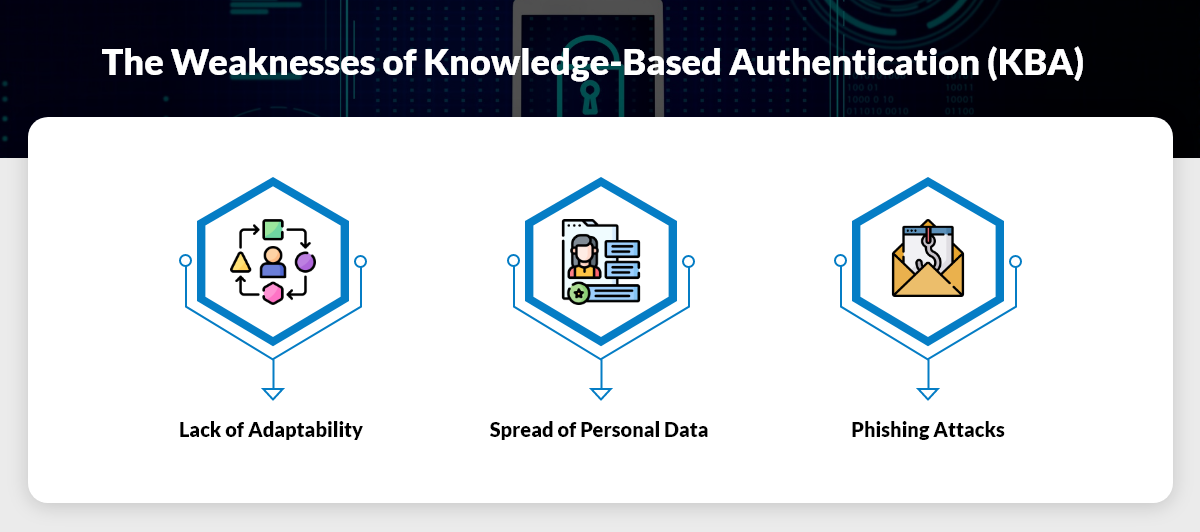The once-standard practice of verifying identity through “secret” questions has become a glaring security risk in an age of data breaches and sophisticated fraud. Today, personal information is easily found online, making it easier to fall prey to digital frauds. But there’s a way out.
Alternatives to knowledge-based authentication (KBA) include multi-factor authentication, biometrics, behavioral analysis, token-based systems, and risk-based authentication. These methods offer stronger security by relying on factors that are difficult to guess, steal, or replicate. For example, multi-factor authentication combines elements like passwords and biometrics, while behavioral authentication uses AI to detect unusual user activity. Compared to KBA, which depends on easily compromised personal information, these modern approaches provide more reliable protection against fraud and unauthorized access.
Wondering what the best alternatives to knowledge-based authentication are? We’ll explore more about it but first, we’ll explain exactly what KBA is, why it needs to be updated, and cover the best alternatives for KBA on the market today.
Table of Contents
- What Is KBA Identity Verification?
- Types of Knowledge-Based Authentication
- How Does KBA Work?
- Challenges and Security Risks of KBA
- Common Use Cases of KBA
- 5 Best KBA Alternatives
- Enhanced Digital Security with KBA Alternatives

What Is KBA Identity Verification?
Knowledge-based authentication (KBA) is a way to prove who you are online.
Common examples include questions like, “What was the name of your first pet?” or “In which city were you born?” Examples include:
- Challenge questions or security questions
- Shared secrets
- Out-of-wallet questions
- Biographical data verification
- PIN-based verification
- One-time passwords (OTP)
- Social media verification
While KBA has seen widespread use for years, several challenges are rendering it less effective in today’s digital environment.

Types of Knowledge-Based Authentication
There are multiple types of KBA that can be used, each with its benefits and attributes.
1. Static KBA
Static KBA is one of those types where personal information that does not change over time is being used. The following are some of the examples of static KBA:
- Date of birth
- The name of the person’s first English teacher
- Mother’s maiden name
- Social security number
2. Dynamic KBA
In contrast to static KBA, this type uses personal information that is liable to change. The following are some of the examples of dynamic KBA:
- Physical address
- Email address
- Phone number
3. Enhanced KBA
Enhanced KBA merges static and dynamic information to provide an extra level of security. This type is often used when a high level of security is required, like financial transactions when accessing personal or sensitive information. This type is used with the individual’s specific needs and requirements.
Is Your KBA Strategy Truly Protecting Your Users?
Your users’ data doesn’t have to be at risk. FTx Identity helps protect their information and boost your security. See How
How Does KBA Work?
Knowledge-based authentication is a security measure that verifies a user’s identity by asking questions only the legitimate user is expected to know. It’s a common method in various online and offline scenarios, designed to add an extra layer of security beyond a simple username and password. The process typically unfolds in these stages:
1. User Initiation
The process begins when a user attempts to access a protected account or service. This could be logging into an online banking portal, attempting to reset a password, or verifying identity during a customer service call. The system recognizes the need for an additional layer of verification beyond the initial login credentials.
2. Prompt for Information
Once initiated, the system presents the user with a series of questions. These questions fall into two main categories:
- Static KBA: These are “shared secrets” that the user sets up in advance, like “What was the name of your first pet?” or “What is your mother’s maiden name?”
- Dynamic KBA (or “out-of-wallet” KBA): These questions are generated in real-time from public or commercial databases and relate to the user’s personal history, such as “Which of these streets have you lived on?” or “Which of these vehicles have you previously owned?” The user has not preselected these answers.
3. Validation
The user provides answers to the KBA questions. The system then compares these responses against the pre-recorded static answers (for static KBA) or against the information held in the external databases (for dynamic KBA). This comparison is performed instantly and securely.
4. Access Granted or Denied
Based on the accuracy of the answers, the system either grants the user access to the requested service or denies it. If the answers don’t match, or if too many incorrect attempts are made, the account may be locked, or further verification steps (like multi-factor authentication) may be triggered. This mechanism is a core component of many knowledge-based authentication solutions.
Challenges and Security Risks of KBA
While KBA offers a seemingly intuitive layer of security, its reliance on shared or publicly available information presents significant challenges and security risks in today’s data-rich environment. This is why many organizations are exploring knowledge-based authentication alternatives.
1. Privacy Concerns

Dynamic KBA often draws information from credit bureaus and other commercial databases. This raises privacy concerns, as users might be uncomfortable with the extent of personal data being accessed and used for verification purposes, even if it’s for their own security.
2. Phishing & Social Engineering Attacks
KBA questions are highly susceptible to phishing and social engineering. Attackers can craft convincing fake websites or impersonate legitimate entities to trick users into revealing their KBA answers. Once these “secrets” are compromised, the KBA layer becomes useless, as the attacker now possesses the very knowledge designed to protect the account.
3. Data Breaches & Credential Stuffing
The proliferation of data breaches means that many static KBA answers (like mother’s maiden names or birthplaces) are already widely available on the dark web. Attackers can use credential stuffing techniques, trying combinations of stolen personal data to answer KBA questions and gain unauthorized access. This significantly undermines the effectiveness of KBA authentication.
4. User Experience Issues
KBA can be frustrating for legitimate users. Forgetting the exact answer to a static KBA question (e.g., “Was it ‘Fluffy’ or ‘Fluffy ‘ with a space?”) or struggling with dynamic questions that might be ambiguous or based on outdated information can lead to lockout and poor user experience. This friction can drive users away or push them towards less secure workarounds.
5. Declining Effectiveness
As more personal data becomes public through social media, data breaches, and public records, the “secret” nature of KBA answers diminishes. What was once considered unique knowledge is now often discoverable, making knowledge-based authentication progressively less effective as a standalone security measure.
Common Use Cases of KBA
Despite its challenges, knowledge-based authentication remains a prevalent security tool across various sectors, often used as part of a multi-layered security strategy or for specific verification scenarios.
1. Banking & Financial Services
Financial institutions frequently employ KBA for identity verification during password resets, suspicious transaction alerts, or when a customer calls support. Questions might relate to past transactions, account balances, or loan details, leveraging the sensitive nature of financial data to verify identity.
2. Healthcare
In healthcare, KBA helps secure patient portals, verify identity for accessing medical records, or confirm appointments over the phone. Questions might involve past medical procedures, prescription history, or insurance details, ensuring that only authorized individuals access sensitive health information.

3. Ecommerce
For high-value purchases, suspicious activity, or account recovery, ecommerce platforms might use KBA. This could involve questions about recent orders, shipping addresses, or payment methods used, adding a layer of security to prevent fraudulent transactions.
4. Government & Legal
Government agencies and legal services use KBA for verifying citizen identities when accessing online services, tax information, or legal documents. This helps ensure that sensitive government data is only accessible to the rightful individual.
5. Customer Support
KBA is a staple in customer support centers. Before discussing account details or making changes, agents often use KBA questions to authenticate the caller, preventing unauthorized access to personal information and ensuring secure service delivery. This is a common application of KBA technology.
5 Best KBA Alternatives

Given these issues, let’s explore the KBA replacement options that can enhance digital security:
1. Multi-Factor Authentication (MFA)
Multi-Factor Authentication (MFA) is a robust alternative to KBA that is gaining rapid adoption due to its enhanced security features.
MFA combines two or more independent factors for identity verification. This typically includes something the user knows (password), something the user has (a mobile device or smart card), and something the user is (biometrics like fingerprints or facial recognition).
By adding these additional layers of security, MFA significantly reduces the risk of unauthorized access.
2. Biometric Authentication
Biometric authentication is a cutting-edge alternative to KBA that leverages unique physical or behavioral traits for identity verification. Biometric data includes fingerprints, facial recognition, voice recognition, and iris scans.
Biometric ID verification is highly secure because it is incredibly challenging to replicate or spoof biometric data.
3. Behavioral Authentication
Behavioral authentication utilizes machine learning and artificial intelligence to analyze user behavior. It assesses patterns in how users interact with systems and applications, such as keystroke dynamics, mouse movements, and device usage.
If a user’s behavior deviates significantly from their typical patterns, it can trigger alerts for potential unauthorized access. Behavioral analytics systems are commonly used in AI verification platforms, for example.
4. Token-Based Authentication
Token-based authentication provides users with a physical or digital token that generates a one-time code or PIN for each login session. The dynamic code enhances security by continually changing, making it nearly impossible for attackers to predict or replicate. Common forms of token-based authentication include hardware tokens and Time-Based One-Time Passwords (TOTP) generated by mobile apps.
5. Risk-Based Authentication
Risk-based authentication is a dynamic alternative that evaluates the risk associated with a specific login attempt. Factors considered may include the user’s location, the device used, and recent activity.
The system may prompt for additional authentication if it deems the risk level to be high based on this assessment. This approach offers a proactive way to adapt to changing threats and provides robust security.

Enhanced Digital Security with KBA Alternatives
As the threat landscape for digital security continues to evolve, it’s crucial to move beyond traditional KBA verification. Alternatives, including MFA, biometric authentication, behavioral authentication, token-based authentication, and risk-based authentication, offer more robust and adaptable security solutions.
1. Enhanced Security: KBA alternatives provide improved security compared to traditional KBA methods. Methods like biometrics and token-based systems are more resistant to fraud and identity theft, reducing the risk of unauthorized access.
2. Reduced Vulnerability to Social Engineering: KBA alternatives are less susceptible to social engineering attacks because they do not rely on easily discoverable personal information. This enhances protection against phishing and other socially engineered attacks.
3. Convenience and User Experience: KBA alternatives often offer a more convenient and user-friendly authentication process. Users appreciate the ease of biometric recognition or token-based systems, which can lead to higher user satisfaction.
4. Lower Reset Costs: KBA alternatives typically reduce the need for costly password resets and customer support interactions. Biometrics and token-based systems decrease the reliance on manual account recovery processes, saving time and resources.
Wrapping Up
As the digital world advances, so do the threats to online security. The limitations and weaknesses of knowledge-based authentication (KBA) are becoming increasingly evident, necessitating the exploration of more robust alternatives.
Multi-factor authentication, biometric authentication, behavioral authentication, token-based authentication, and risk-based authentication are emerging as promising KBA replacements. In an era where online security is paramount, these KBA alternatives provide a path towards enhanced protection and peace of mind.
And with innovative solutions like FTx Identity on the horizon, the future of digital security looks even more promising. FTx Identity, armed with cutting-edge technology and a commitment to safeguarding your online presence, stands poised to become a pivotal player in the ongoing quest to strengthen our digital defenses.
